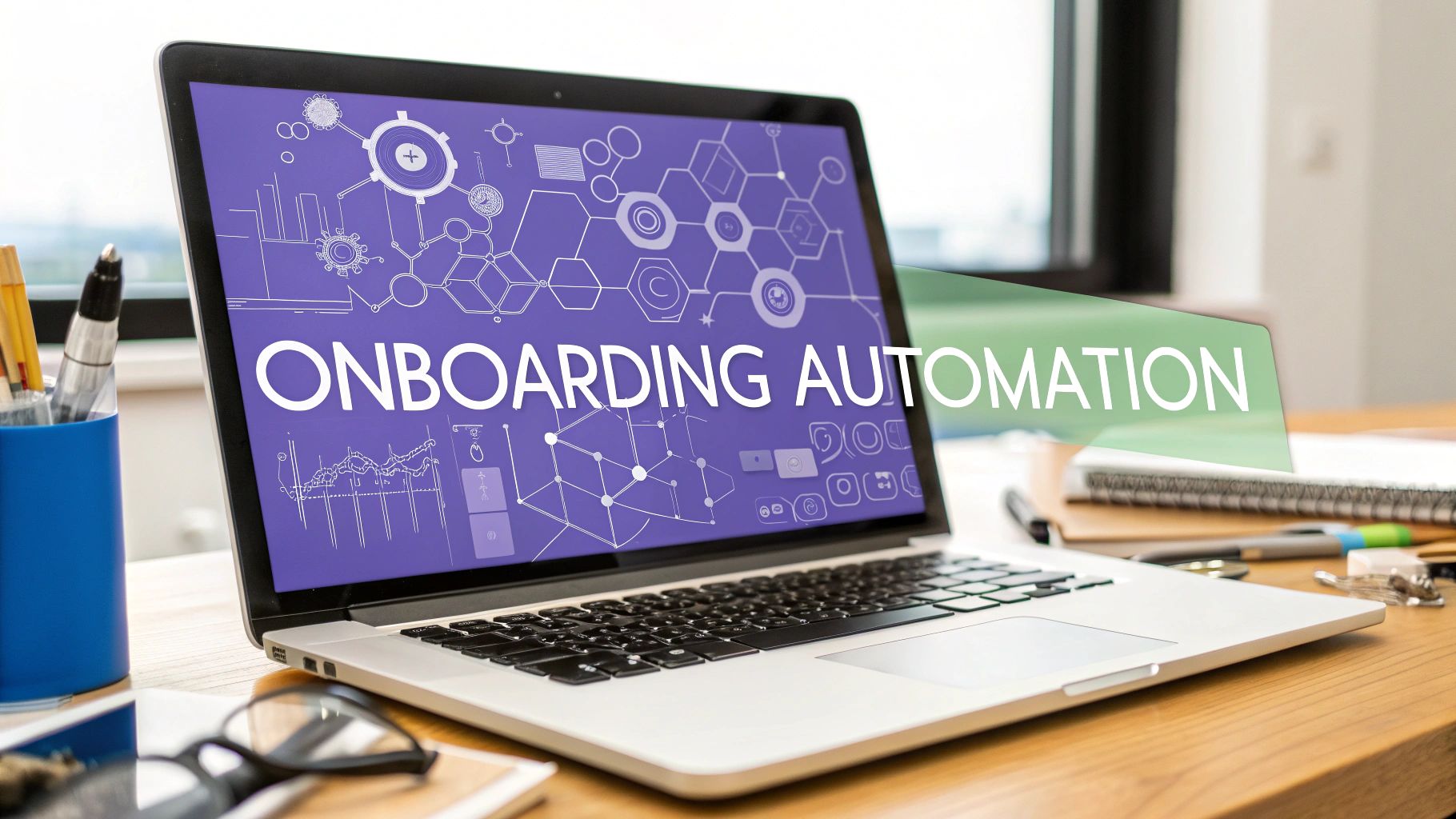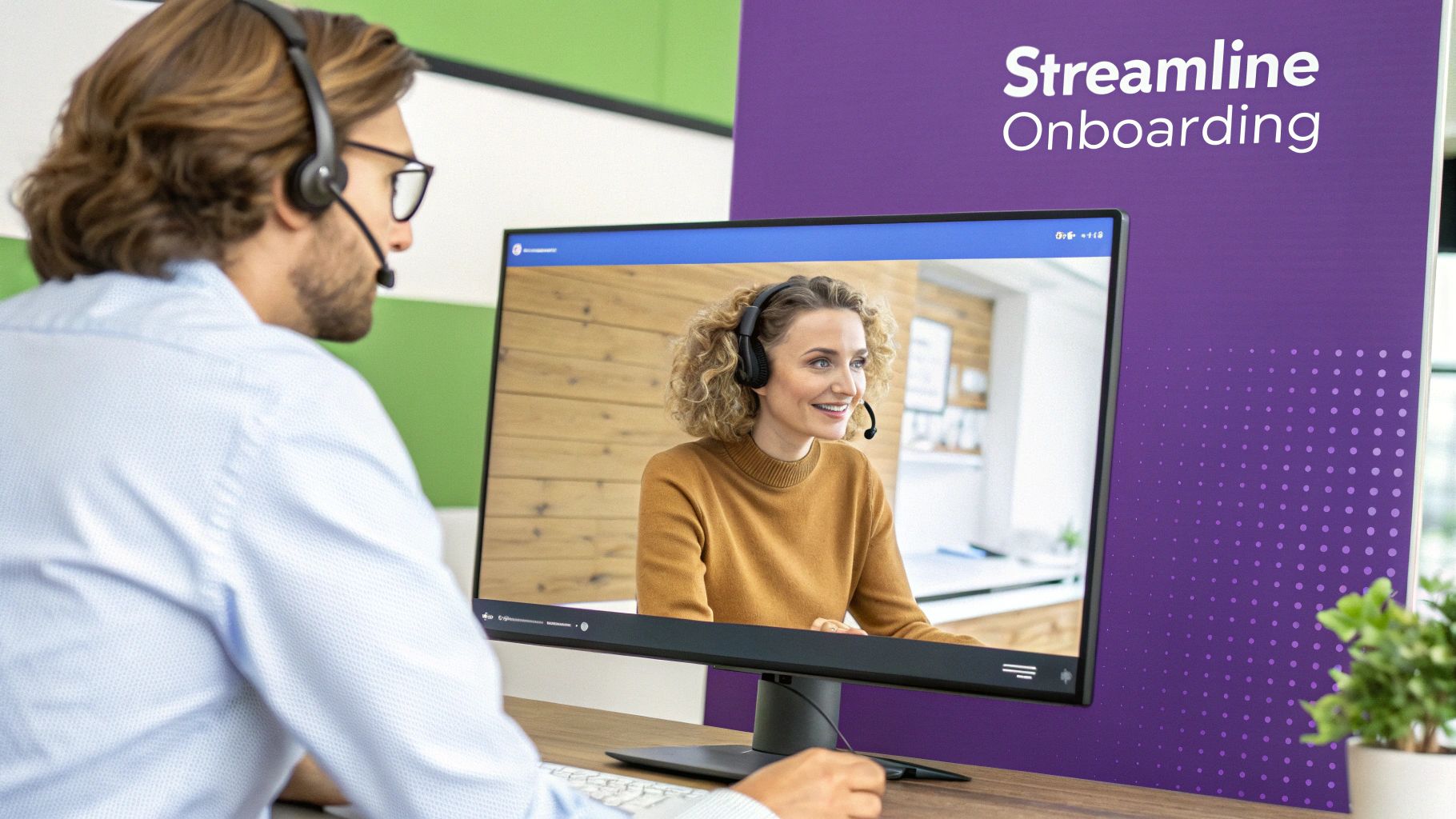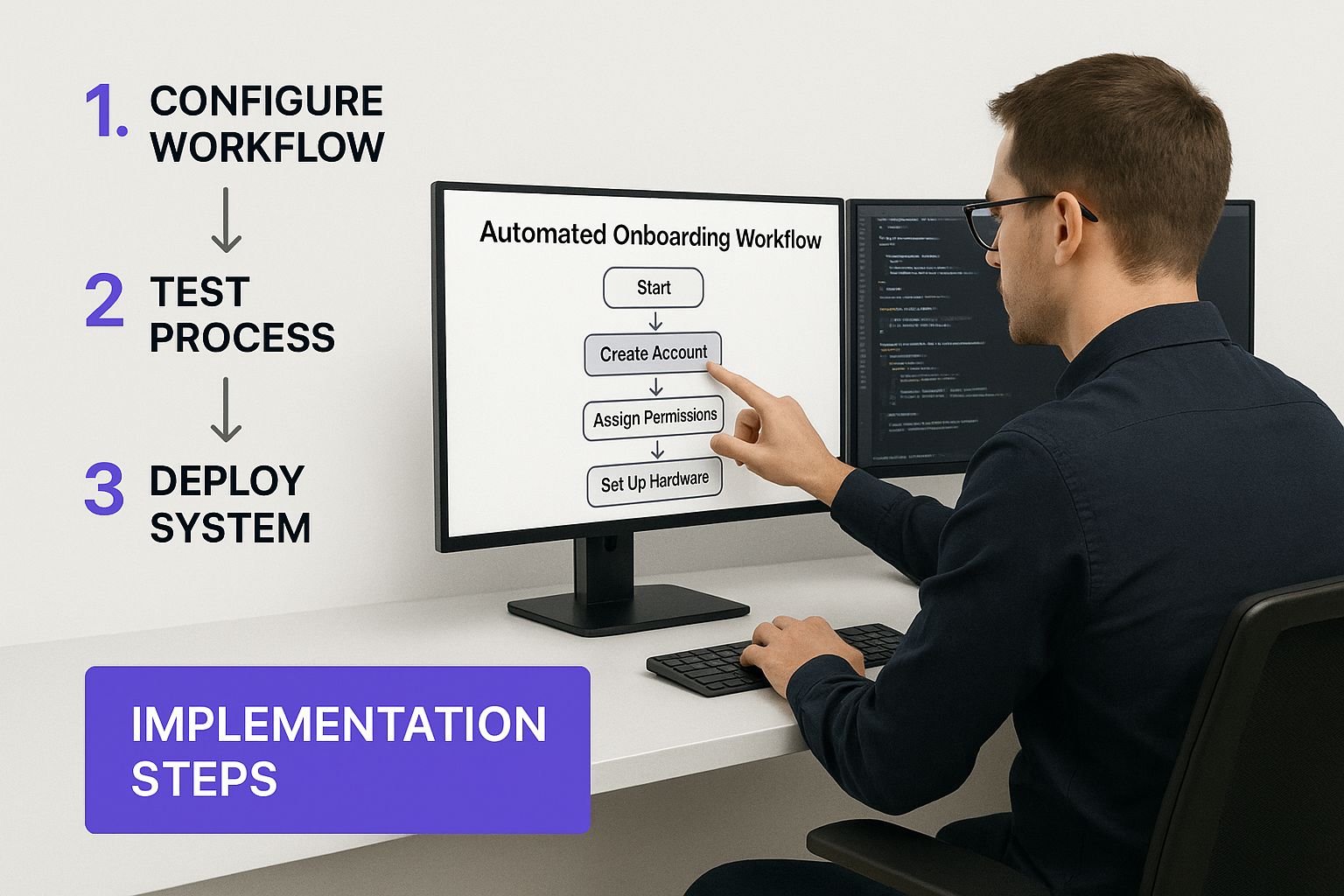
Let’s be honest: giving every single new customer a personal, one-on-one tour of your product would be incredible. But as your business grows, that’s just not realistic. This is precisely where customer onboarding automation comes into play.
Think of it as your digital co-pilot, intelligently guiding new users through your service so they can find real value, fast. It's the secret to turning curious signups into happy, long-term customers who actually use your product.
At its core, customer onboarding automation is a carefully designed, automated journey that steers users toward their "aha!" moment—that critical point where they truly understand the value your product brings to their life or work.
Instead of relying on manual emails and calls, this approach uses a smart system of triggered messages, in-app guides, and interactive checklists. It’s what bridges the gap between a customer hitting the "sign up" button and them becoming a proficient, successful user. Before we get into the tech, it's worth getting a firm grip on the foundational principles of customer onboarding that all great systems are built on.
A common misconception is that automation is about replacing the human touch. It’s not. It’s about making that human touch count for more.
Think about the grind of traditional onboarding: manually sending welcome emails, chasing people down for demo calls, and answering the same basic setup questions over and over. Automation takes all of that off your plate. This frees up your customer success team to focus on what they do best—building relationships and solving the complex, high-value problems that a machine can't handle.
The real goal of automation isn't to remove your team from the picture, but to make their involvement more meaningful. When you automate the basics, your experts can step in at the most critical moments, turning potential churn risks into your biggest fans.
To see just how much of a difference this can make, let's compare the two approaches side-by-side.
This table breaks down the key differences between a traditional, hands-on onboarding process and a modern, automated system. It highlights the major shifts in scalability, consistency, and resource allocation.
As you can see, the shift to automation isn't just about efficiency—it's about creating a fundamentally better and more reliable experience for your customers.
A well-designed automated system delivers a seamless and consistent journey for every single user, no matter when or where they sign up. No one gets missed or falls through the cracks.
This is achieved by weaving together a few key elements that work in harmony:
This strategic approach does more than just show people around; it turns new users into confident, empowered customers from day one.

Let's move past the theory. What does customer onboarding automation actually look like for a real business? Picture a growing SaaS company, we’ll call them "ConnectSphere," struggling with a high rate of early-stage churn. Their small customer success team is completely overwhelmed, trying to manually guide hundreds of new signups every single month.
The result is a messy, inconsistent experience. Some new users get a demo call, others get a welcome email a week late, and far too many are left to fend for themselves. This inconsistency leads directly to user frustration, poor product adoption, and a customer lifetime value (CLV) that's heading in the wrong direction. This is where automation stops being a buzzword and starts delivering real business outcomes.
By putting an automated onboarding system in place, ConnectSphere changes the game. The most immediate impact is on user activation. Instead of waiting for a human to get in touch, every new user now receives an instant, personalized welcome with a clear path forward.
The main goal of automation here is to get users to their "aha!" moment as fast as possible—that magic point where they truly see the value in what you offer. For our friends at ConnectSphere, this means getting a user to create and share their first project.
With automation, this critical process is standardized and fine-tuned. A user who completes this key action is far less likely to churn. It's not uncommon for companies to see user activation rates double after setting up automated walkthroughs, which translates directly to better long-term retention.
A well-automated onboarding process does more than just say hello. It actively proves your product's value. It turns those crucial first few days from a period of confusion into a guided journey toward success, making retention a natural outcome instead of an uphill battle.
This proactive guidance builds momentum and user confidence, turning what was once a major reason for churn into a solid foundation for a long-term customer relationship.
Maybe the most powerful benefit of all is the ability to grow without letting quality slip. ConnectSphere can now bring on 10,000 new users with the same precision and consistency as they did for 100. Every single user gets the same polished, helpful experience, 24/7, no matter their time zone.
This frees up the customer success team to shift their focus. Instead of getting bogged down in repetitive, low-impact tasks, they can now dig into the user behavior data flowing from the automated system. They can pinpoint customers who are genuinely stuck and offer high-touch, strategic help where it counts. This mix of customer onboarding automation and human expertise delivers incredible results:
Ultimately, automation turns onboarding from a costly, manual bottleneck into a powerful, data-driven engine for sustainable growth and, of course, more revenue.
A truly effective automated onboarding strategy isn't just one big, clunky workflow. It's much smarter than that. Think of it as a carefully built system with different parts, each designed to help new users find their footing at every step of their initial journey. It’s less like a rigid instruction manual and more like a friendly, intelligent guide that knows what a user needs, right when they need it.
This whole process kicks off the very second someone signs up. That's your golden opportunity to make a great first impression and show them exactly what they stand to gain from your product.
As you start piecing together your own strategy, it’s always a good idea to ground your work in proven customer onboarding best practices. This ensures you're building on a solid foundation.
That first interaction has to feel personal, not like it came from a robot. You can use the information you gathered during sign-up—like their job role, industry, or what they hope to achieve—to fire off a welcome email or in-app message that speaks directly to them.
For example, imagine a project management tool. A user who signed up as a "Project Manager" could get a welcome sequence focused on setting up teams and building timelines. Meanwhile, a "Team Member" would see a different message highlighting collaboration features. This kind of immediate relevance shows you're already paying attention to their unique needs.
This isn’t just a nice-to-have anymore; it's essential. The SaaS industry is a perfect example of why customer onboarding automation is so critical for keeping customers around. The global SaaS market was valued at roughly $317.55 billion and is expected to soar past $1 trillion by 2032. With that kind of growth, the competition is fierce, making that initial user experience more important than ever.
Nobody wants to read a static help document anymore. Modern customer onboarding automation brings the learning directly inside your app with interactive elements that guide users in real-time.
The best in-app guidance doesn't just explain what a button does. It encourages users to take a meaningful action that results in a small victory. This is how you build momentum and confidence.
This guidance can come in a few different flavors:
A social media scheduling tool, for instance, could use a checklist to walk a new user through connecting their first social account, drafting their first post, and then scheduling it. Each time they check an item off the list, they get a small dose of satisfaction and move one step closer to seeing why they signed up in the first place. This hands-on approach is worlds more effective than just reading about how to do something.
Alright, you've got your strategy mapped out. Now for the fun part: bringing your customer onboarding automation to life. This is where the theoretical plans become a real, working system that guides your new customers toward success. It’s less like flipping a switch and more like carefully building a well-oiled machine.
The whole point is to turn those high-level goals into concrete, automated workflows that engage customers from the moment they sign up. The infographic below breaks down the major phases of this journey.

As you can see, successful implementation isn't a one-and-done deal. It's a continuous cycle: you map the journey, build the automated sequences, and then fine-tune everything based on how real users interact with it. Each step logically follows the last, creating a powerful and effective onboarding experience.
Before you can automate a single email or in-app message, you need a crystal-clear picture of the path your customers should take. Think of it like drawing a treasure map. You need to trace every single step, from their very first login to that critical "Aha!" moment where they experience a real win with your product.
What are the key milestones on this map? For a project management tool, it might be creating their first task list. For an analytics platform, it could be generating their first report. These moments are the foundation of your entire automated system.
Your customers aren't all the same, so why would you give them the exact same onboarding? Group your users into distinct segments based on their role, company size, or even the goals they told you about during signup. This lets you build different onboarding paths that speak directly to what each group needs.
A marketing manager, for example, needs a completely different introduction to your tool than a developer does. This targeted approach makes the whole experience feel more personal and gets them to value faster by cutting out the noise. In fact, companies that nail this have slashed the time it takes to onboard a new customer by as much as 80%.
With your journey mapped and your user segments defined, it's time to pick your tools. Your tech stack doesn't have to be complicated, but it does need to work together. It will likely include:
The key is to select tools that integrate seamlessly with each other and can grow with you.
Now you get to build it all out. This means writing the copy for your emails, designing your in-app guides, and setting up the triggers that kick everything off. If you need a solid framework to make sure you don't miss a step, using a detailed customer onboarding checklist can be a huge help here.
Start with a pilot test. Don't unleash your new system on everyone at once. Roll it out to a small, controlled group of new users first. This gives you a safe space to find and fix any bugs or awkward spots before it goes live to your entire customer base.
Launching your automation is the start, not the finish line. The final—and ongoing—step is to keep a close eye on your key metrics. Watch things like the completion rates for your onboarding checklists, how long it takes users to hit those key activation milestones, and their overall engagement.
This data is pure gold. It will show you exactly where people are getting stuck or losing interest, giving you the insights you need to continuously refine your workflows and make them even better.
Picking the right software for customer onboarding automation can feel overwhelming. The market is flooded with options, but the good news is they generally fall into a few distinct categories. Once you understand these categories, you're halfway to finding the perfect fit for your business and, more importantly, for your new customers.
Your choice really boils down to two things: how complex your product is and what your customer's journey looks like. A tool that's perfect for a simple mobile app would be completely out of its depth with a sprawling enterprise SaaS platform. This isn't about chasing the flashiest features; it's about matching a tool's strengths to what you're trying to achieve with your onboarding.
Most automation tools can be grouped by their main job. While many platforms have overlapping features, they almost always have one area where they truly shine.
All-in-One Digital Adoption Platforms (DAPs): Think of these as the heavy lifters for complex software. DAPs like UserGuiding or Appcues specialize in in-app guidance, letting you build interactive walkthroughs, helpful tooltips, and progress checklists right inside your product.
Email Marketing Automators: Tools like Mailchimp or ConvertKit are masters of communication outside your app. They're built for creating smart, behavior-triggered email sequences that can welcome new users, share educational content, and gently nudge them back if they go quiet.
Customer Relationship Management (CRM) Systems: A CRM like HubSpot or Salesforce acts as the central nervous system for all your customer data. While not strictly onboarding tools themselves, they are crucial for connecting the dots, triggering workflows in other platforms based on a user's subscription tier, activity, or lifecycle stage.
The best approach is rarely about picking just one. A powerful strategy often involves a "stack" where a DAP handles the hands-on, in-app experience, an email platform keeps the conversation going, and your CRM makes sure everything is perfectly timed and personalized.
This integrated setup creates a seamless experience for your customer, no matter where they interact with your brand.
Take a hard look at your product. Is it a sophisticated SaaS tool with a steep learning curve? A Digital Adoption Platform would be a game-changer here, guiding users through critical setup tasks and cutting down that initial confusion. In fact, this approach can speed up the process by 60% just by reducing manual effort.
On the other hand, if you run a more straightforward subscription box or content service, you might not need intensive in-app tours. For you, a well-crafted email automation strategy that highlights different product benefits over the first few weeks could be far more effective at building a loyal customer. The goal is to figure out where your users stumble and give them a hand right there.
To help you map your needs to the right kind of tool, here’s a quick breakdown of the main categories.
This table will help you see at a glance which type of tool aligns best with your product's complexity and your specific onboarding goals.
Ultimately, choosing the right tool starts with a deep understanding of your customer's needs. By identifying their potential friction points, you can select a platform—or a combination of platforms—that makes their journey from newcomer to power user as smooth as possible.

While today's customer onboarding automation is great at following rules, the next wave is all about true artificial intelligence. We're moving away from simple "if-this-then-that" sequences and into a much smarter, more predictive world. Think of systems that can guess what a user needs, sometimes even before the user knows it themselves.
This is where AI-powered hyper-personalization comes in. Picture an onboarding experience that literally changes shape based on how a user interacts with it—analyzing their clicks, pauses, and successful actions to instantly serve up the next best step. It’s all about giving each person the exact guidance they need, right when it matters most.
A huge piece of this future is the development of genuinely intelligent AI assistants. This is a massive leap forward. Industry forecasts suggest that AI will be part of 95% of all customer interactions soon, and we're already seeing chatbot adoption hit roughly 80% among customer service teams. You can dive deeper into these customer experience statistics on OnRamp.us.
These AI systems won't just field basic questions. They'll be able to diagnose tricky problems, suggest creative solutions, and offer instant, 24/7 support that actually feels helpful.
The real game-changer with AI is its ability to be proactive. Instead of waiting for a user to hit a wall and get frustrated, machine learning models can spot the early warning signs of someone struggling or about to churn. This triggers the system to jump in with targeted help, turning a potential friction point into a positive, successful moment.
By anticipating roadblocks and adapting to how each person learns, AI is poised to make onboarding feel incredibly intuitive and personal. The goal is to make every user feel understood and guided from the second they start using your product.
Even with the best plan in place, moving to a new system is bound to bring up some questions. It's only natural. Let's walk through some of the most common things people ask about customer onboarding automation so you can feel completely confident moving forward.
This is the big one, right? It's essential to prove the value of your efforts. While it’s tempting to just point to cost savings from less manual work (and that's definitely part of it!), the real impact shows up in your core growth metrics.
Think about tracking these numbers before and after you roll out automation:
When you see these numbers move in the right direction, you have a powerful, data-driven story to tell about your investment.
It’s a totally fair concern. Nobody wants their customers to feel like just another number in a machine. But here's the secret: the point of automation isn't to get rid of the human touch. It's to make it count.
When you automate all the repetitive, predictable stuff, you free up your customer success team to focus on what they do best—solving complex problems and building genuine relationships.
Automation handles the predictable parts of the journey, so your team can master the pivotal moments. A well-timed personal check-in from a CSM after a user completes an automated workflow feels thoughtful, not robotic.
They are! And that’s exactly why user segmentation is so crucial. A one-size-fits-all automated flow is doomed from the start.
You absolutely have to create different onboarding paths based on what your users need. Think about their roles, what they want to achieve, or even the size of their company. An administrator setting up the entire account needs a completely different set of steps than a team member who just needs to learn one specific feature.
Great customer onboarding automation is all about delivering the right journey to the right person. Get that right, and you’ll see engagement soar from day one.
Ready to stop reacting and start building proactive, data-driven customer relationships? Statisfy uses AI to turn your customer data into actionable insights, helping you automate management tasks and focus on what truly matters. Discover how Statisfy can elevate your customer success strategy today.